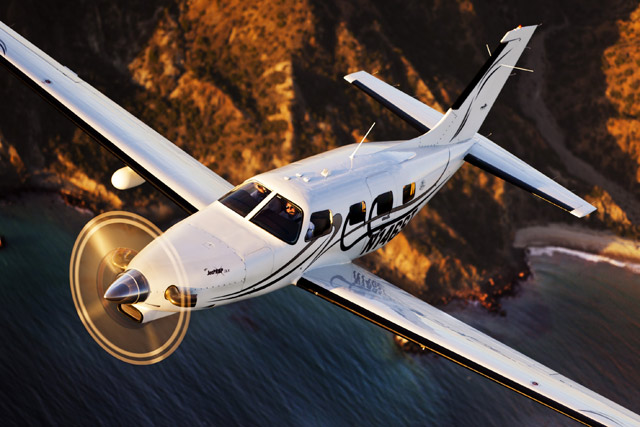
Piper’s sleek Malibu/Mirage pressurized singles have always been good performers once they get up to altitude. It’s the takeoff and climb phases that leave a little to be desired. JetProp LLC’s DL and DLX conversions solve that with an infusion of an extra few hundred horsepower.
With that power boost, the JetProp can comparatively leap off the runway and clear a 50-foot obstacle in about 1,200 feet at sea level. Landing distances are even shorter with the aid of reverse thrust. At altitude, the DLX can cruise at 260 KTAS at FL270 on about 31 gph or just more than 200 pounds per hour. RVSM limits the JetProp to altitudes of FL 280 and below.
DL and DLX are Roman numerals for 550 and 560, the shaft horsepower created by the conversion’s Pratt & Whitney PT6 engines. The DL uses a PT6A-21 engine and burns about four gph less than the DLX’s PT6A-35. The DL is also about 10 knots slower. The not-so-modest difference is the DL’s much lower price tag. JetProp says about 20 percent of the conversions are DLs.
Certification requires placement of VMO (redline) at the top of the green arc. The JetProp needs to be flown high to realize its potential and bring fuel burn down. Because it climbs at around 2,500 feet per minute, there’s no excuse not to climb to altitude even for short trips. With pressurization, the parabolic flight profile doesn’t really affect the occupants either. Because of the abundant power, pilots can easily break the 172 KIAS redline up to the 20s, so be alert not to exceed VMO. Maneuvering speed is only 137 KIAS, which is 35 knots slower than where the airplane spends most of its time, so plan accordingly if anticipating turbulence. Piper’s Meridian turboprop, which arrived a few years after the JetProp, utilizes a horizontal stabilizer that’s 37 percent larger than the JetProp’s stock Malibu/Mirage tail to better absorb the added power. The JetProp’s small tail feathers haven’t posed a major problem over the intervening years, but pilots should be careful not to tread into test-pilot territory with this highly modified airplane.
Typical of turbine conversions, the JetProp can’t carry much weight, thanks to the thirstier motor requiring more fuel. Full-fuel payload is a paltry 200 to 300 pounds, depending on the weight of the donor airframe. Empty weights average in the 3,100-pound range. Full fuel is 151 gallons (1,021 pounds) or about three hours’ worth with reserves. If trips are short, fuel can be left behind to boost payload. Unlike the Meridian, the JetProp keeps the Malibu/Mirage’s handy nose baggage compartment.
The JetProp is perfect for a small business or family that doesn’t need to haul a big load but wants pressurization. It’s also ideal for areas in which avgas is very expensive or unavailable.
Pete Bedell is a pilot for a major airline and co-owner of a Cessna 172 and Beechcraft Baron D55.
SPEC SHEET
JetProp DLX
Conversion price $529,000-$599,900
Powerplant | 560-shp Pratt & Whitney PT6A-35
Length | 30 ft 1 in
Height | 11 ft 3 in
Wingspan | 43 ft
Seats | 6
Max takeoff weight | 4,340 lb
Takeoff distance over 50-ft obstacle | 1,200 ft
Max cruise speed | 250-260 kt
Landing distance over 50-ft obstacle | 1,000 ft
Range | 1,000 nm
Photography by Mike Fizer


